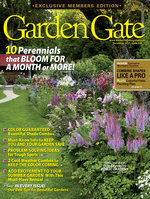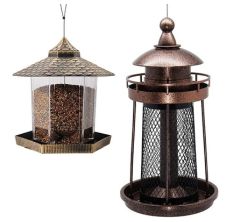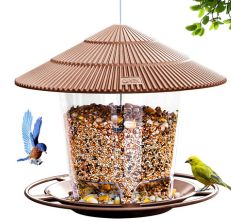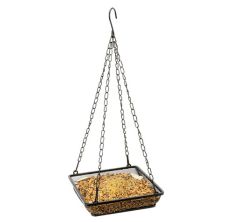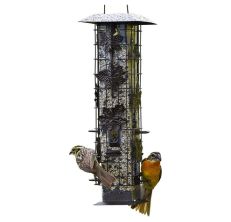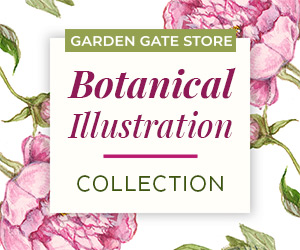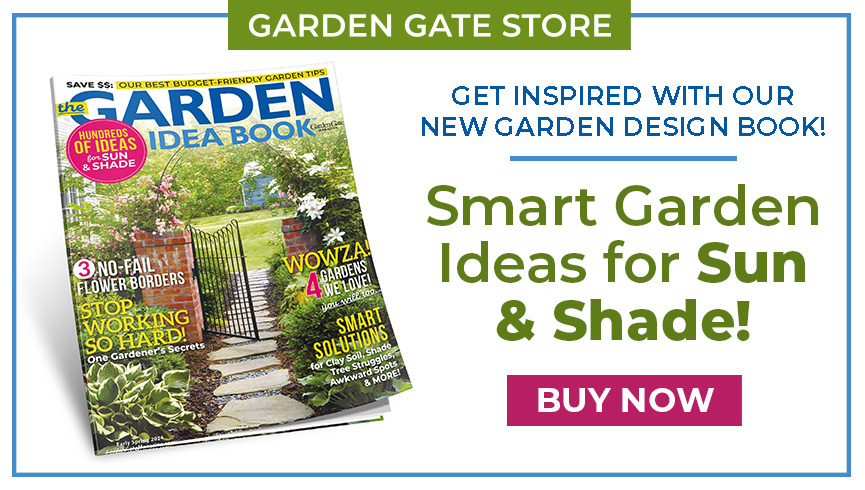I used to hang up bird feeders in my outdoor space and would marvel at the feathered friends who came to visit. If you like to birdwatch, a hanging bird feeder is a non-disruptive way to observe birds and keep them coming around for a long time. In this review guide, we will explore various attractive feeders that can hold a lot of seeds and are strong and durable. Our team especially likes the unique design, easy installation, and compact size of the Twinkle Star Hanging Bird Feeder, which is why it is the best overall.
Our Top Picks For Hanging Bird Feeders
Hanging Bird Feeders: A Buyer's Guide
The melodious songs and graceful flights of tiny birds bring a sense of unmatched tranquility and connection with nature. Investing in a hanging bird feeder can let you invite these delightful creatures into your everyday life. That way, you can create a symbiotic relationship of mutual appreciation. However, there are so many options to choose from, making it difficult to find the right hanging bird feeder for you. But don’t worry! Our comprehensive buying guide can give you valuable insight into the selection process. By exploring the factors below, you can make an educated decision and get a front-row seat to the mesmerizing world of avian wonders.
How To Pick the Right Hanging Bird Feeder for You
Capacity
Bird feeders come in various sizes with different capacities. If you plan to feed a large flock of birds, it is important to buy a bird feeder that can accommodate that. Some feeders can hold as much as eight kilograms of seed, so keep that in mind. Alternatively, you might want to opt for a smaller feeder if you’d prefer to attract fewer birds.
Type of feeder
Most hanging bird feeders are designed to dispense seeds. That said, other options have multi-purpose designs. These make it possible to offer other food items, such as suet, nuts, mealworms, or jelly. It is important to choose the type of feeder that suits the food you plan to offer to the birds in your area.
Construction
Bird feeders are made out of various materials, including metal, plastic, and wood. Metal and plastic feeders are generally more durable and weather-resistant than wooden feeders. However, they also tend to be more expensive. Wooden feeders are typically less expensive. At the same time, they often require more frequent maintenance and have more intense cleaning requirements due to their natural material.
Mounting system
Some hanging bird feeders are designed with a hook or pole at the top. This makes them easy to mount on trees or posts. With this system, you can change the feeder’s height. That way, birds can easily reach the food from multiple angles. Alternatively, some feeders might need to be attached directly to walls or fences with the help of nails and screws.
Drainage
Hanging bird feeders have drainage holes at the bottom. These help the seeds stay dry while preventing the growth of mold. Plus, some bird feeders have a mesh bottom so water and debris can fall through instead of collecting at the bottom of the container.
Predation protection
Squirrels and other predators can be a major issue when you want to feed wild birds. That’s why it is important to purchase a hanging bird feeder that has protective features. These may include squirrel baffles or predator guards. The goal is to discourage opportunistic animals from stealing food or damaging the feeder.
Visibility
When shopping for a hanging bird feeder, it is important to consider the visibility of the feeder from a distance. You’ll want to ensure that birds can easily find the feeder. That’s why brightly colored or patterned feeders are smart ideas. They can help attract more birds, especially when compared to plain feeders. That’s because vibrant bird feeders will easily stand out amongst the foliage in your garden or yard.
Cleanliness
Cleanliness is key when it comes to attracting birds. So, look for a hanging bird feeder that is easy to disassemble. Clean it regularly with warm water and detergent soap. That way, you can reduce the bacteria that grow and prevent fungal from developing on seeds, suet, or other food items in the container.
Portability
Occasionally moving your hanging bird feeder is always a good idea. This can help you keep predators away while offering birds new food sources every time they visit your garden. Try to choose a lightweight bird feeder that has an easy-to-use mounting system. This will make it easy for you to relocate the bird feeder without hassle or too much effort.
Price
Keep the cost of the hanging birdfeeder in mind. Make sure it is within your budget. At the same time, try not to compromise on the quality or functionality of the bird feeder just for the sake of spending less money. Instead, look for models that offer excellent value while providing all the essential features you want or need.
People Also Asked
How high should I hang my bird feeder?
The ideal height for a bird feeder is around five to six feet off the ground. This distance provides a safe and accessible height for birds while simultaneously minimizing the likelihood of predators accessing the feeder.
Can I hang multiple bird feeders close to each other?
Yes, you can hang multiple bird feeders close together. However, it's important to ensure that there is plenty of space between them. This will help prevent overcrowding and lower the likelihood of conflicts arising between birds competing for food.
How often should I clean my hanging bird feeder?
Regular cleaning is crucial when you want to maintain the health of the birds. It can also help you prevent the spread of diseases. Clean the feeder at least once every two weeks. Do this more regularly if you notice mold, feces, or other signs of contamination.
Should I hang my bird feeder in direct sunlight or the shade?
Placing your bird feeder in partial shade is generally recommended. This helps keep the food fresh for longer by preventing it from spoiling too quickly in direct sunlight while providing enough bird visibility.
How can I prevent squirrels from raiding my hanging bird feeder?
To prevent squirrels from raiding your hanging bird feeder, consider using a squirrel-proof feeder with features like baffles or cages that deter squirrels. Place the feeder at least 10 feet away from trees or structures that squirrels could jump from, and use a baffle or greased pole to prevent them from accessing the feeder from below. Regularly clean the feeder to remove any spilled seeds that might attract squirrels.

